Summer/Fall 2023
Barter Theatre’s Early Years

Collections Spotlight: Letters from Vietnam
Secretariat: America’s Horse
Luray Caverns: Jewel of the Virginia Landscape

Summer/Fall 2023
Barter Theatre’s Early Years

Collections Spotlight: Letters from Vietnam
Secretariat: America’s Horse
Luray Caverns: Jewel of the Virginia Landscape
Secretariat: America’s Horse page 22
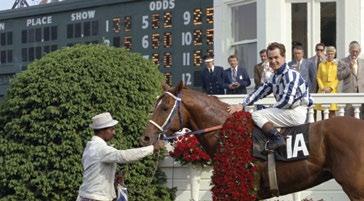
Barter Theatre’s Early Years

page 6
Collections Spotlight: Letters from Vietnam
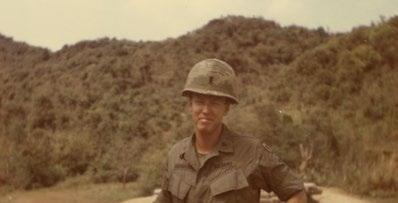
page 14
Luray Caverns: Jewel of the Virginia Landscape

page 26
Giving Spotlight
News & Notes
page 31
page 30
Cover: Barter Theatre, Performing “Walking Across Egypt” and “Little Women”, 2013
Virginia History & Culture No. 17
Questions/Comments
newsletter@VirginiaHistory.org
428 N Arthur Ashe Boulevard Richmond, Virginia 23220 VirginiaHistory.org
804.340.1800
Galleries and Museum Shop
Open 10 am – 5 pm daily
Research Library
Open 10 am -5pm, Monday - Saturday
NEWSLETTER TEAM
Editor
Graham Dozier
Designer/Production
Cierra Brown
Contributors
Jamie Bosket, Danni Flakes, Tracy Schneider, William Rasmussen
EXECUTIVE TEAM President & CEO
Jamie O. Bosket
Chief Financial Officer
David R. Kunnen
VP for Advancement
Anna E. Powers
VP for Collections & Exhibitions
Adam E. Scher
VP for Guest Engagement
Michael B. Plumb
Associate VP for Human Resources
Paula C. Davis
VP for Marketing & Communications
Tracy D. Schneider
VIRGINIA HISTORICAL SOCIETY BOARD OF TRUSTEES
Chair
Richard Cullen*
Vice Chair
Carlos M. Brown*
Immediate Past Chair
Pamela Kiecker Royall*
Honorary Vice Chairs
Austin Brockenbrough III
Harry F. Byrd III*
Nancy H. Gottwald
Conrad M. Hall*
Thomas G. Slater, Jr.*
Regional Vice Chairs
William H. Fralin, Jr.
Susan S. Goode*
Gen. John P. Jumper
Lisa R. Moore
The Virginia Museum of History & Culture is owned and operated by the Virginia Historical Society—a private, non-profit organization established in 1831.
Makola M. Abdullah
Neil Amin
Victor K. Branch*
Charles L. Cabell
Jeanette R. Cadwallender
Victor O. Cardwell
Herbert A. Claiborne III
William C. Davis
Joanie D. Eiland
Peter F. Farrell
Victoria D. Harker
Russell B. Harper
C. N. Jenkins, Jr.
Edward A. Mullen
John R. Nelson, Jr.*
Kevin B. Osborne
Xavier R. Richardson
Elizabeth A. Seegar
Gerald F. Smith, Jr.*
J. Tracy Walker IV
*Executive Committee
In just three years’ time, we will mark a major American milestone—the 250th anniversary of our nation’s independence. We should embrace this historic moment—extraordinary in our lifetimes—and act upon it by together renewing our commitment to the unfinished pursuit of A More Perfect Union. We need to reflect deeply on our past and invest with great purpose in our future.
Our American experiment is unique in human history—a government of laws and not of individuals; a government by the people and for the people, founded on the selfevident truth that all are created equal and are endowed with the universal rights of Life, Liberty, and the pursuit of Happiness. In our first two and a half centuries, our nation, through the determination of its people, and with its unlimited capacity for reinvention and renewal, has progressed in its journey—working to fulfill, through struggle and sacrifice, the promise of our founding for all Americans. There is much to celebrate, to reflect on, and aspire to.
The VMHC, your state history museum, is uniquely positioned—a trusted voice in a tumultuous time—to connect Virginians and Americans with their compelling and collective story and to shine a light on the founding of our nation and our dramatic journey over the ensuing centuries. Building on our recent success, the VMHC is ready and able to seize this exceptional opportunity for all Virginians—to educate and inspire.
This summer we will share more of our ambitious plans to mark this most important American milestone, a multi-year portfolio of major exhibitions, public programs and events, publications, and far-reaching educational initiatives.
In the pages that follow, we are most pleased to highlight a foundational piece of our big plans: the creation of an innovative new civics center made possible by the John Marshall Center for Constitutional History & Civics becoming part of the VMHC.
Through this rare joining of forces, the VMHC will bring important educational programming to an increasing number of students and adult learners across Virginia and beyond.
Thank you for joining us as we begin this exciting new chapter. As always, I send you my most sincere gratitude for all you do to enable this timely work.
Sincerely,
Jamie O. Bosket, President & CEO The John Marshall Center for Constitutional History & Civics to become part of the VMHC!Learn more on page 4!

This Fourth of July, the Virginia Museum of History & Culture will launch a major three-year initiative to lead Virginia and the nation in marking the 250th anniversary of American independence, a once-in-a-generation moment that brings with it countless opportunities for celebration and reflection.

To kick off this initiative, the VMHC announces longtime partner, the John Marshall Center for Constitutional History & Civics (JMC), will join its organization, effective July 4, to create an innovative new civics education center that will revolutionize civics education in the Commonwealth, empowering history and civics to work together to inspire and educate current and future generations. Through this rare joining of two private non-profit organizations, the VMHC will bring important educational programming to an increasing number of students and adult learners across Virginia and beyond. This development becomes reality after many years of collaboration and more recent consideration of how the two organizations
might be stronger together. Their shared history and aspirations, as well as the fundamental link between history and civics, make this an ideal move that will serve more Virginians than ever before.
One of the nation’s oldest historical institutions and the oldest in the Commonwealth, the VMHC was founded in 1831 with, rather fittingly in this context, Chief Justice John Marshall as its first chairman. For nearly two centuries, the museum has increasingly served Virginians through its preservation and education mission. Today, the museum stewards one of the finest historical archives in the nation, totaling more than nine million items. Now, the archives of JMC will join those of the VMHC, and together will inform compelling history and civics programming that serves both current and future generations.
Founded in 1987, the JMC has done exceptional work in both advancing knowledge of constitutional history and civics and in documenting the life and legacy of
Chief Justice John Marshall. Programs for students, like Justice in the Classroom and PopCiv, provide the essential lessons needed for a sound understanding and appreciation of the rule of law, constitutional rights and responsibilities, and the core functions and history of our government. Public programs like the Marshall Scholar Series convene learners of all ages in meaningful, non-partisan dialogue about the judiciary, constitutional history, and the state of our union.
By becoming a signature study center within Virginia’s history museum, the JMC gains tremendous new scope and scale at a particularly opportune time, and VMHC is empowered to do something truly impactful and lasting for America’s 250th—to be a new hub for history and civics taught in unison and provided for the benefit of all people, launched at a time when far too few Americans know the basics of history and civics.
Recent findings from the U.S. Department of Education show that student proficiency in civics and in history have declined to levels unseen since testing began in the 1990s. Now, through this rare merger of two historic institutions, Virginia gains a new and powerful tool to invest in a bright future for all Virginians, and to empower a more informed and engaged citizenry.
For happily, the government of the United States, which gives to bigotry no sanction, to persecution no assistance, requires only that they who live under its protection should demean themselves as good citizens, in giving it on all occasions their effectual support.
– George Washington, August 17, 1790
Only 1 in 3 Americans (36%) can actually pass the U.S. Citizenship Test, which only requires correct answers to 60% of the history and civics questions asked.1
Take the test at VirginiaHistory.org/CitizenTest
Less than half of U.S. adults (47%) could name all three branches of government. 1 in 4 respondents couldn’t identify even one.2
Only 1 in 4 U.S. adults could name a single right provided by the First Amendment to the U.S. Constitution.2
The coming together of these two likeminded organizations will benefit hundreds of thousands of Virginians over the coming months and years. It will also provide new and compelling opportunities for the loyal supporters of the VMHC and the JMC. VMHC members will get full access to JMC’s programming, including the Marshall Scholar Series, which brings the best and brightest minds together for discussions on constitutional history, law, and America’s Founding. Supporters of the JMC, through VMHC membership, will gain unlimited free access to the museum and the robust programmatic portfolio it offers.
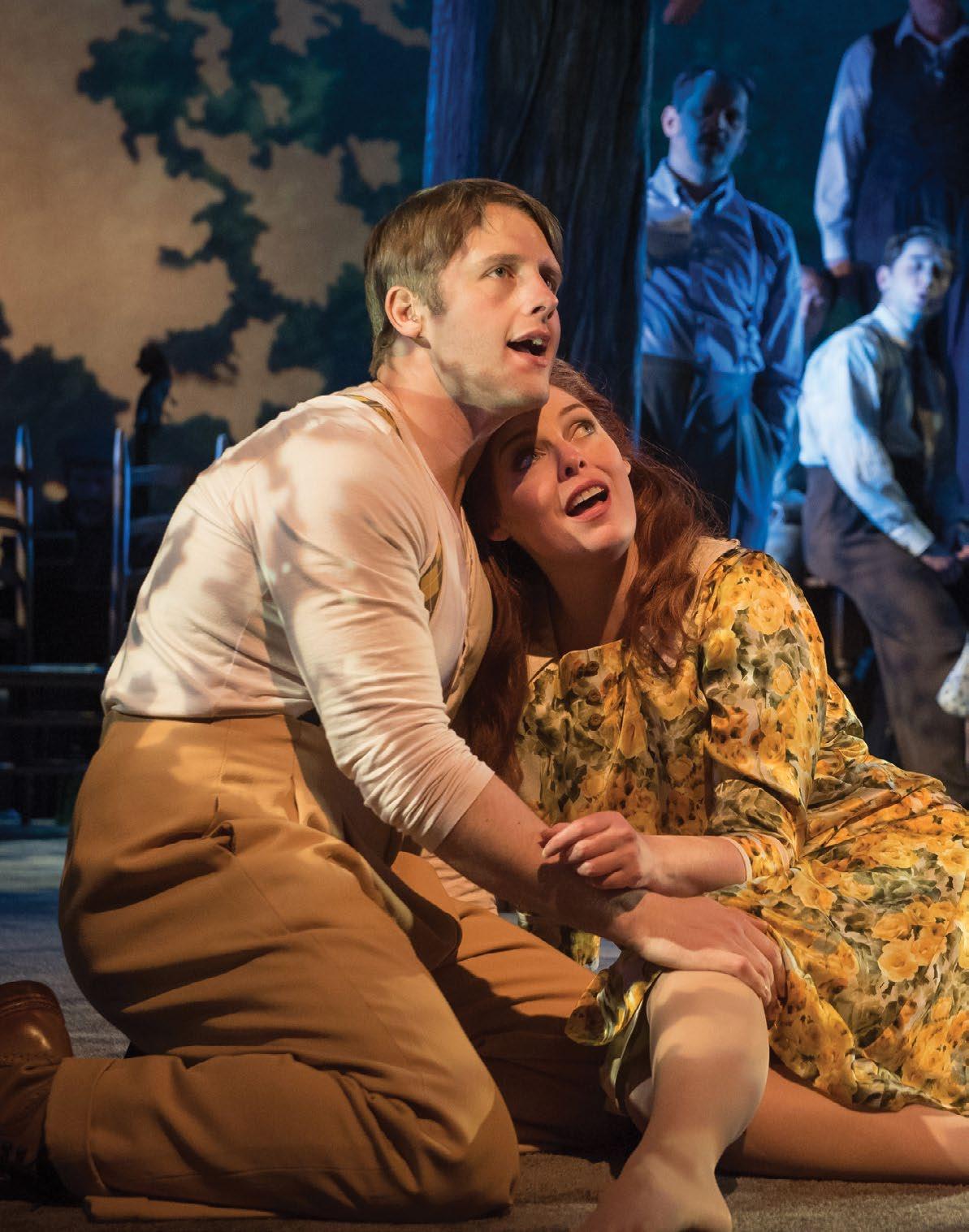 The cast of “Bright Star,” Barter Theatre, 2018 (Courtesy of Barter Theatre).
The cast of “Bright Star,” Barter Theatre, 2018 (Courtesy of Barter Theatre).
On June 10, 2023, Barter Theatre, the State Theatre of Virginia, celebrated its 90th Anniversary. Barter was established during the Great Depression to create work for unemployed theater performers, writers, and stagehands in a region hungering for the arts. Robert Porterfield, Barter’s founder, was a Broadway actor. As the Great Depression wore on and no work was to be found, Porterfield, a native of southwest Virginia, remembered an opera house sitting empty in the small town of Abingdon. He was also aware that local farmers were struggling to sell the food they grew. So, Porterfield convinced a group of actor friends to join him in Abingdon for the summer, and together they created a bartering theater where people could trade food for tickets to a performance. Admission was 35 cents, or the equivalent in “victuals.” Their slogan was, “with vegetables you cannot sell, you can buy a good laugh.” In the first season, the theater made less than $5, but there was a collective weight gain of more than 300 pounds among the actors. Barter Theatre has been running strong ever since.
The early years of Barter offer a fascinating look at theater history. Robert Porterfield was intent on people understanding that great art belonged to everyone, not just those who could afford it or people in big cities. Barter was at the forefront of the regional theater movement

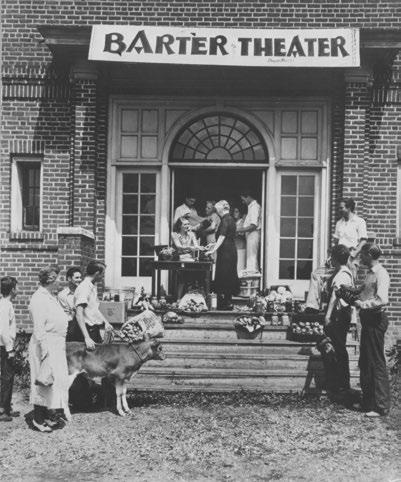
that encouraged the creation of professional theaters throughout the nation. Barter also held an annual award ceremony in New York City (The Barter Awards) wherein the best actor and actress in a Broadway show received a Virginia Ham, a plot of Virginia land, and the right to choose an apprentice for the next season at Barter. Playwrights from Noel Coward to Thornton Wilder accepted Virginia ham as payment for the rights to do their plays at Barter. Barter paid George Bernard Shaw, a vegetarian, in spinach. Tennessee Williams sat on the steps of the Martha Washington Inn, which served as housing for Barter Theatre, and wrote a play for the theater to produce. In 1946, Barter was the first in the nation to be named a State Theatre, and it won the first regional Tony Award two years later.
Gregory Peck—so they almost always said yes. Patricia Neal was just sixteen years old when her local preacher recommended her to Barter. She was an apprentice there, and she valued the experience so much that she sponsored the salary of an acting apprentice until the day she passed away in 2010. Those fortunate enough to win the distinction of a Patricia Neal Scholarship at Barter enjoyed maintaining correspondence with her during their award terms and would have the opportunity to lunch with Patricia when she came into town. Ned Beatty, another celebrated actor whose career started at Barter, credited the theater with teaching him to act. His son became Barter’s technical director in the 1980s.
Robert Porterfield was a force of nature, evidenced by the new life he breathed into the idling opera house in Abingdon and the illustrious names who trained there during his tenure. A Southern gentleman, he was by all accounts charming, handsome, larger than life, and dedicated to Barter Theatre. When he passed away in 1971, many feared the theater would shutter. But Rex Partington, who had worked with Porterfield for many years, stepped forward to become the second producing artistic director, and he saw the theater through the next twenty years of its story. Many organizations stumble when they lose their founders, but Partington and his family worked together to ensure that Barter continued to bring professional theater to the region and to secure its legacy.
Barter began before the days of widespread fine arts programs, a time when actors serious about their careers apprenticed with established companies. Some of Barter’s famous alumni from this period include Gregory Peck, Ernest Borgnine, Patricia Neal, and Hume Cronyn. While acting at Barter, Gregory Peck also worked in the props department. Barter was still making little money at the time and had almost no budget for sets and props, so Peck would drive a truck through town, knock on doors, and ask to borrow furniture for shows. He was not yet famous, but he looked—well, like
When Partington retired in the early 1990s, a national search found Richard Rose, who ushered in a period of unprecedented growth. Barter conducted a complete renovation of the historic theater and turned its smaller Smith Theatre into another year-round professional performance space. Barter’s staff of three grew to 130. The theater became one of the only true resident companies in the country, in which artists—including the actors and artisans who create the shows—live and work together year-round on a repertory of shows. The Resident Acting Company is usually in two shows while

they are rehearsing two more. The model allows patrons to see four or five different shows, even if they are only in Abingdon for two days. Barter’s and Abingdon’s tourist business grew exponentially; 145,000 visitors began to come to the town annually, and restaurants, bed and breakfasts, and local businesses blossomed.
Starting in the early 2000s, Barter also began impactful playwriting programs that fostered the work of established writers and those who were brand new to the field. The Appalachian Festival of Plays and Playwrights began showcasing plays that tell the authentic stories of this region. Since its inception, plays that have come through the festival have gone onto performances across the nation, carrying the stories of Appalachia far and wide. The College Playwrights Festival began fostering student playwriters through readings, rehearsals, workshops, and mentorship. In the last two decades, the Young Playwrights Festival has helped thousands of high school students across the region learn the basics of playwriting.
Barter Theatre has performed for young people throughout its history, including performances at the theater as well as tours to schools and performing arts venues. What started as a local tour grew to include all of Appalachia, then to national and international tours. Student audiences at the theater also grew substantially and, in 2018, Barter’s youth programming served more than 100,000 children.
In 2020, as Katy Brown began her first season as producing artistic director, succeeding Richard Rose and the development he facilitated, Barter Theatre encountered the next twist in its history: the COVID-19 pandemic. Like theaters across the world, Barter had to close its doors in March of 2020. But with a community dependent on Barter’s patrons, the theater found a way to produce performances safely. There was a rundown drive-in movie theater on the edge of town called the Moonlite, which had sat empty for years. The speaker poles had been bashed in; Locals described it as a wasteland—but it was the perfect place to experiment
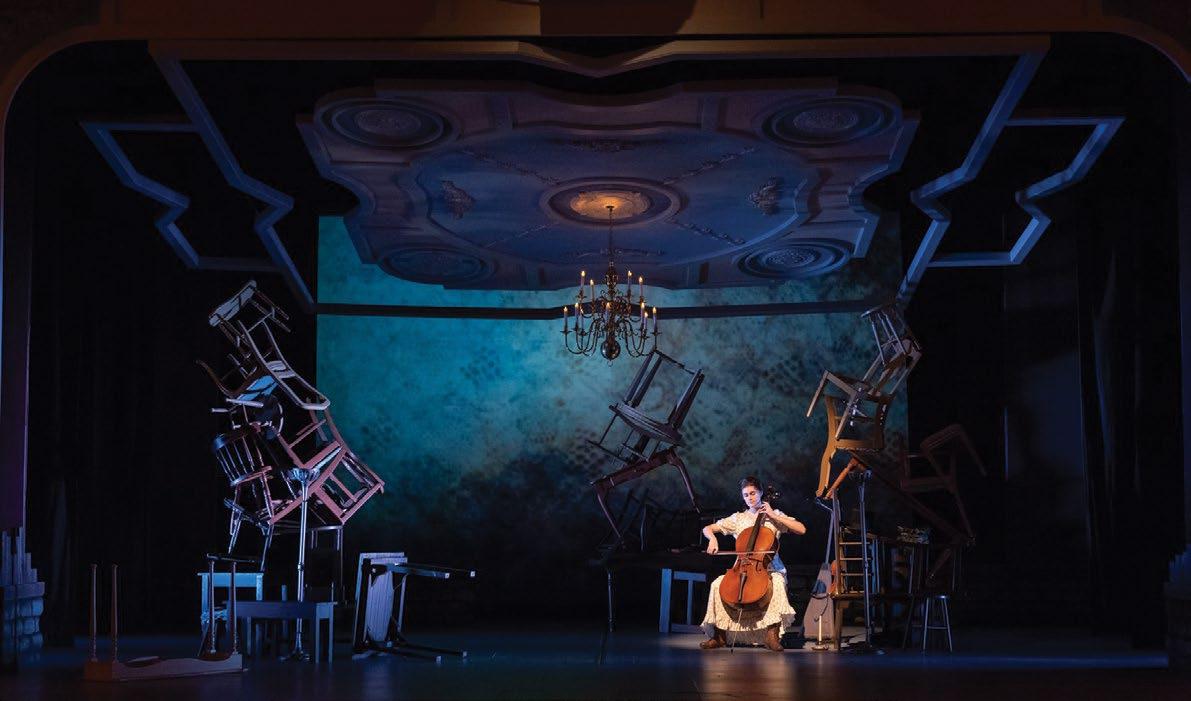 Bethany Dawson in “Great Expectations” at Barter Theatre, 2018 (Courtesy of Barter Theatre).
Bethany Dawson in “Great Expectations” at Barter Theatre, 2018 (Courtesy of Barter Theatre).
with outdoor theater. Local business leaders, volunteers, and Barter’s staff came together to tidy and renovate the space. They mounted a stage where actors could perform plays live under the stars. Barter retrained its crew members so that they could shoot the shows live with cameras, the images of which they projected above the actors’ heads on the movie screen. From the comfort of their car, patrons could watch the actors on the stage or, for close ups, on the screen. The actors lived in a “Quaranteam” and saw only each other, so that they could perform together safely. Barter was one of the first theaters in the world to be producing live shows during the pandemic, and the audience had a Barter experience unlike any other in its long history. Audiences would applaud by flashing their lights and honking their horns. Guests brought their dogs, had cook outs, and sometimes stood next to their cars and wept because they had a way to share theater while socially distancing. Over the next two
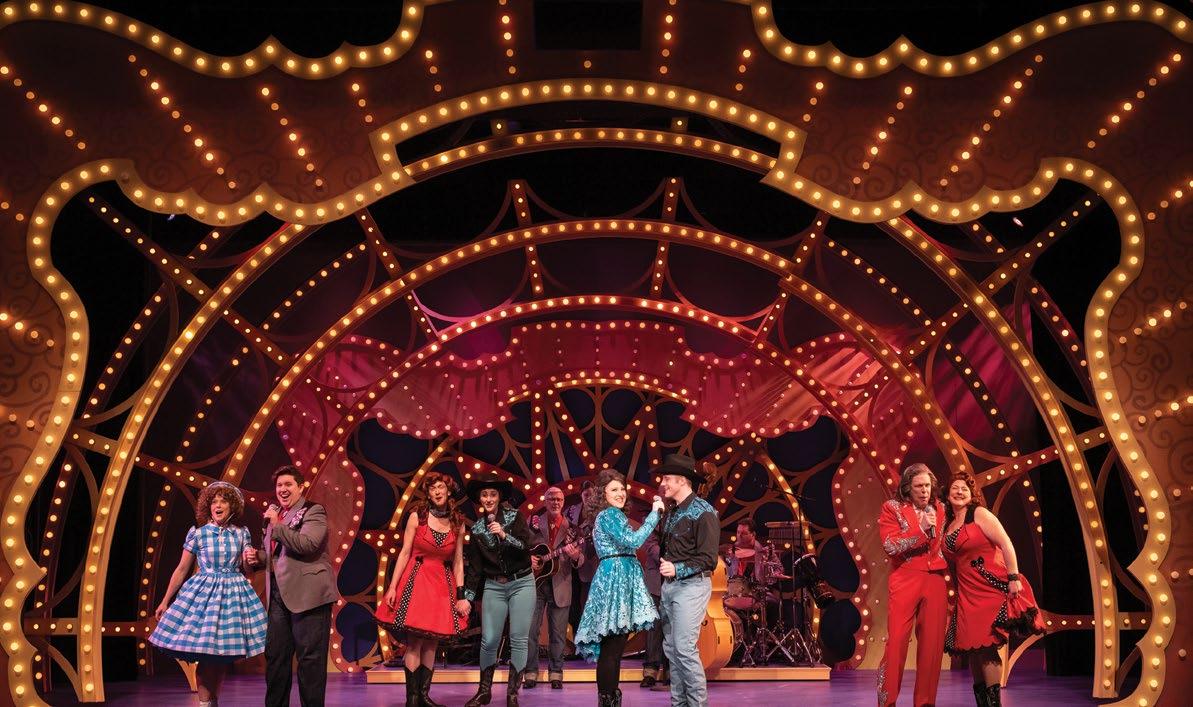
 Terrance Jackson onstage at Moonlite Drive In (Courtesy of Barter Theatre)
The cast of Madame Buttermilk on stage at Barter, 2019 (Courtesy of Barter Theatre).
Terrance Jackson onstage at Moonlite Drive In (Courtesy of Barter Theatre)
The cast of Madame Buttermilk on stage at Barter, 2019 (Courtesy of Barter Theatre).
Today, Barter is back inside its two theaters, performing plays, musicals, new works, and classical texts with its Resident Company. Audiences travel from around the region and around the world to experience the work of its artists. Barter’s shows for young audiences and playwriting festivals are back in person, and the excellence of the theater is only growing. Barter is in its second year of its Black Stories Black Voices initiative, in which members of the region’s Black community share stories and histories with Black writers from the around the country, who then build monologues, scenes and plays. As Barter marks its 90th Anniversary this summer, both its staff and loyal audiences look back in gratitude at all that has come before, knowing that these efforts brought Barter to where it is today.
Individuals who have traveled the world to chase arts and performance think especially highly of Barter Theatre. Not only does Barter deliver exceptionally good theater, but it is truly a center for the community. The audience believes in the mission of the Barter and loves the artists who work there and the shows they perform; they have shown from Barter’s inception that they value this theatre as they value food. It’s an audience whose grandparents traded ham for Hamlet, and whose grandchildren will connect with the legacy of the past through this theater. It’s an audience that comes from far away to see Appalachia, and an audience from

Appalachia that comes here to see the world. Above all, it’s an audience whose love is palpable. It is their theater, and they tend to it as much as those who work there. All are encouraged to visit Barter, and to see what all this love is about, 90 years and growing.
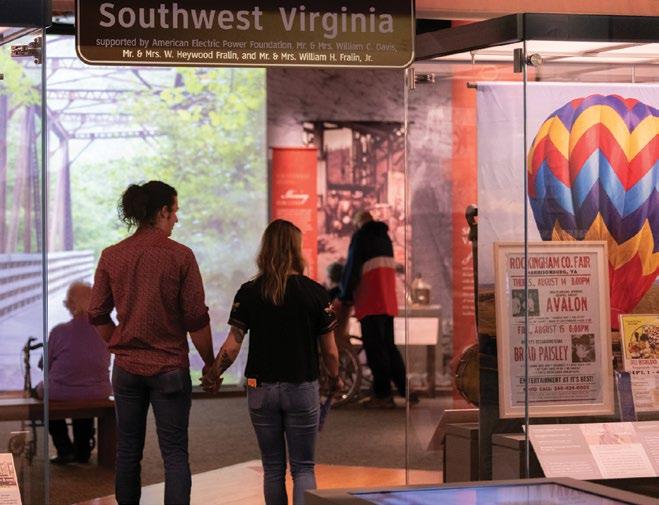 By Katy Brown
Brown
By Katy Brown
Brown
Front Lawn Fun
This free, family-friendly program will feature outdoor games and toys from yesteryear as well as Spacethemed activities in honor of our special exhibition, Apollo: When We Went to the Moon
Tuesdays, Through Aug. 15 10:00 am to noon
Stories at the Museum
Join VMHC’s Education staff for a story and a craft. Tickets to Stories at the Museum include admission to the museum so plan to stay and take a look around the galleries after the program.
Thursdays, Through Aug. 17 10:30 am
First Fridays at the VMHC
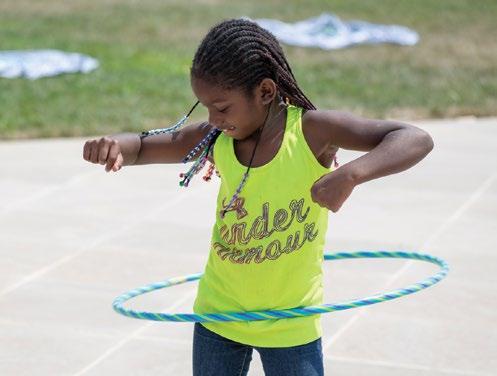
The museum stays open late for this family-friendly event. Enjoy free admission to the galleries, specials in the Café, access to food trucks, live music, and familycentered activities.
First Friday each month 5:00 pm to 8:00 pm
Apollo All-Ages Highlight Tours
Education staff and docents will introduce you to Virginia’s role in the space race through thirty-minute highlight tours.
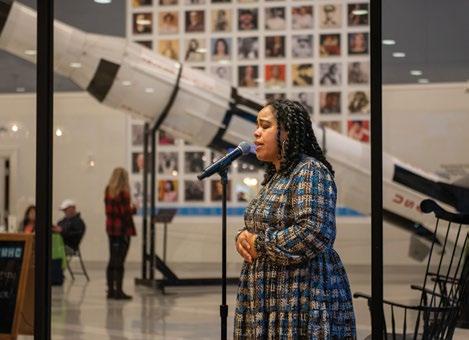
Saturdays, Through Aug. 26 11:30 am
These themed presentations by VMHC staff members provide an opportunity for guests to examine museum artifacts not regularly on display.
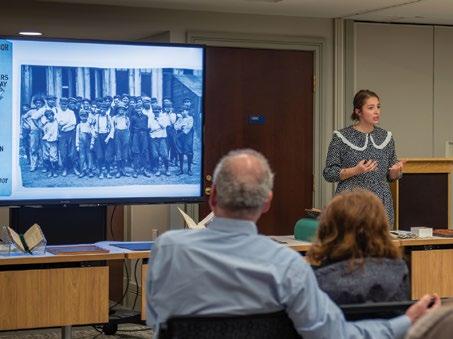
Gettysburg’s Southern Front
by Hampton NewsomeJuly 6 12:00 pm
Constitutional History of Virginia
by Brent TarterJuly 13 6:00 pm
Apollo to the Moon: A History in Objects
by Teasel Muir-HarmonyJuly 20 12:00 pm
Virginia’s Lost Appalachian Trail
by Mills KellyAug. 3 12:00 pm

Almost Dead: Slavery and Social Rebirth in the Black Urban Atlantic, 1680-1807
by Michael DickinsonAug. 17 6:00 pm
Escape to the City: Fugitive Slaves in Antebellum
Richmond (Virtual Only)
by Viola Franziska MüllerSept. 21 12:00 pm
Across the Airless Wilds: The Lunar Rover and the Triumph of the Final Moon Landings
by Earl SwiftOct. 5 12:00 pm
BrewHaHa
August is Virginia Craft Beer Month. Join the VMHC for this annual event featuring beer selections and breweries from across the Commonwealth, live music, food trucks, and after-hours access to the galleries.
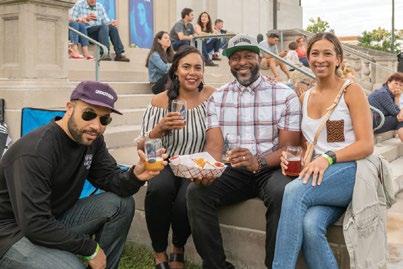

Aug. 5 6:00 pm
Virginia Distilled
September is Virginia Spirits Month. Join the VMHC for samples of spirits produced by Virginia distillers, live music, food trucks, and after-hours access to the galleries.
Sept. 9 6:00 pm
Virginia Vines
October is Virginia Wine Month. Virginia Vines will feature wine selections from some of Virginia’s best wineries and vineyards, live music, food trucks, and after-hours access to the galleries.
Oct. 21 6:00 pm
Registration is required for both free and paid programs at VirginiaHistory.org/Calendar
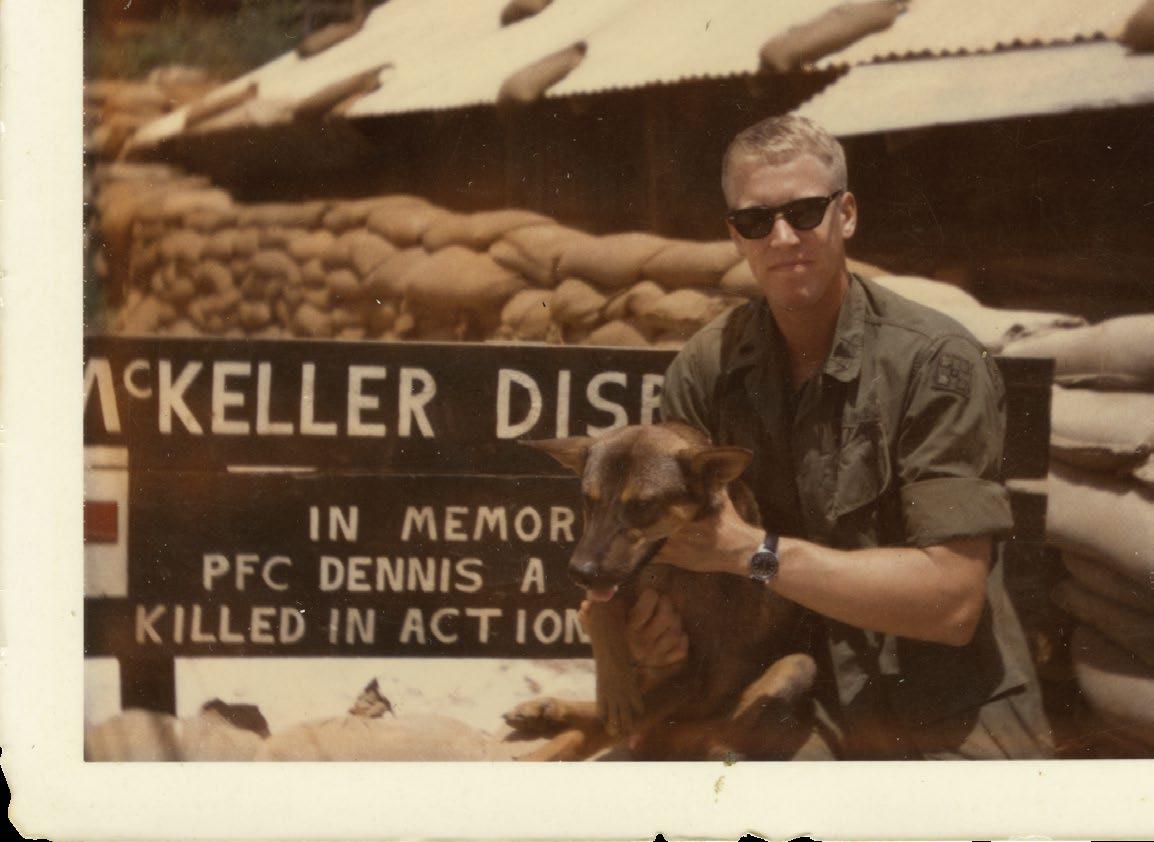
 Top: Lt. Rasmussen at the McKeller Dispensary at Pleiku with “Keats,” a dog he and his men adopted, August 1967 (Courtesy of William Rasmussen).
Top: Lt. Rasmussen at the McKeller Dispensary at Pleiku with “Keats,” a dog he and his men adopted, August 1967 (Courtesy of William Rasmussen).
John Curtis Rasmussen, Jr. (1943–2009), a Richmond native and graduate of the Virginia Military Institute, was deployed to Vietnam for the calendar year 1967. A pre-med major at VMI, he was trained by the army to serve as a battalion surgeon’s assistant. In that position he commanded a team of medics and managed the medical operations at a succession of forward command posts established in the central highlands and coastal region by the 3rd brigade of the 25th (and later 4th) infantry division, as that brigade searched for the enemy. During that hazardous service, he earned the Combat Medical Badge, for service ”under fire” in a “ground combat” engagement. Many around him did not survive, including one of his medics. Letters that he wrote to his family in Virginia document a year-long journey.
After the war, Rasmussen earned a Ph.D. in history and served as an assistant to two U.S. congressmen and to one senator, and then worked for the International Trade Commission of the Department of Commerce, where he earned the Bronze Medal Award for Superior Federal Service. During those years he rarely spoke to his family about his Vietnam experiences. His story, however, is preserved in 65 letters and 78 Polaroid photographs he sent home to his worrying mother and grandmother (his father had died), his brother, three aunts, and a few close family friends.
This powerful collection of letters and photographs will become part of the VMHC collection thanks to the generosity of Dr. William Rasmussen

Extracts from the letters home are printed here, along with several of the photographs. The interest in history that led Lt. Rasmussen to graduate school in that field accounts for the wealth of historic information that is included in the letters. He saw history happening in Vietnam and he recorded it:
Practical training at Medical Field Service School, Fort Sam Houston, Texas, before deployment, 27 March 1966: “The work is becoming more interesting now, as it’s a bit of everything. They say we will be ‘jacks of all trades & masters of none.’ There are about 300 of us, including quite a few pharmacists.... The 500 doctors they drafted last month are here now & of course aren’t too military & don’t seem too happy about it.... My friend from VMI who is here now took my course in Sept. & is now taking another course to prepare him for Viet Nam. He’s going in July....”

14 January 1967: “I couldn’t ask for a better assignment. This is not much of a camp as most everything is in tents, but I live in about the best building here—the battalion dispensary—with several of my NCO’s which is somewhat unusual.... This place is as safe as any over here I suppose. The airfield was shelled several nights last week but it’s about a mile away in somewhat of a valley. They wouldn’t have much luck attacking this camp. In fact I’m much safer than I should be. The brigade is out in the field most of the time, but I will be here at the base camp most of the time, and the battalion surgeon stays in the field with the troops!”
27 January 1967: “Well I’ve got to go check on some of my men; they’re manning 2 bunkers tonight since 1/2 of ‘C’ company is out on ambushes leaving only half here to guard the CP. We called in some air strikes on several of the surrounding hills & are hoping the enemy hasn’t fled.
Don’t worry about me; you never hear of colonels or doctors getting killed & I know God’s looking out for me.”
2 February 1967: “[T]his damn Chinese new year truce coming up... may well ruin the 2 months of blood & sweat we’ve put into this operation. We are so close to a North V. regiment, but if we don’t catch them by next week, this truce will give them a chance to either get away or attack us in force & kill us all while our hands are tied. I’m convinced that human life means no more to [President Lyndon] Johnson than to Mao [Zedong] or Ho [Chi Minh].”
8 February 1967: “I’ve already written Mr. [Congressman David] Satterfield and Sen. [Harry] Byrd about the [poor] mail [service] & this damn truce. It started last night & there have already been 22 violations—according to radio Australia. No one got any sleep last night because a large enemy force had been spotted moving into this area in our direction. Because of the truce we couldn’t touch them & they knew it.
We’ve been in this area over a month & had just about cleared it out (rumor had it that we’d be leaving this week), but now we’ll have to start over again.... Now we don’t know where they are or whether they intend to shell us or attack us. If they ever had a golden opportunity to do it, this is it & they’d like nothing better than to destroy our artillery, which is an integral part of our concept of operations in this terrain. I can think of no period in our history, where the lives of our troops have meant so little. And now I’m a sitting duck too.”
13 February 1967 [from Senator Harry F. Byrd, Jr.]: “My dear Lieutenant Rasmussen:—
Thank you for your letter which I received this morning. Yours is a thoughtful and well-reasoned letter.
I am most interested in your first-hand report from Viet Nam—especially was I interested in your statement about the captured North Vietnamese medical supplies which were from America. I shall be discussing this with my colleagues on the Armed Services Committee....
You might be interested to know, that my youngest son is a Private in the Marine Corps and will be going to Viet Nam within a few months.
To you I send my best wishes.”

23 February 1967 [from Congressman David E. Satterfield III]: “Dear John:
“This is to acknowledge your letter of the 5th. I cannot agree with you more about the observance of truces in Viet Nam…. I shall do all I can to oppose any future observances.
We are well aware of the thefts that have occurred in our shipments to Viet Nam, including medical supplies. Efforts are being made to spot this….
I have written several times about mail and hope it will improve….
Please let me hear from you again and the best of luck to you.”
12 March 1967: “It’s true what they say about this being the only country where you can stand up to your knees in mud & have the wind blow dust in your face.
This idea of a truce getting us home is ridiculous. The worst possible thing we could do is sign a truce & then pull our troops out of here. This would destroy everything we have accomplished & we would probably have to start all over again. But this seems to be [President Lyndon] Johnson’s goal. We didn’t do it in Germany or Korea, but it’s desired here. I would really feel like I had been sold out. There are only 2 solutions: destroy North V[ietnam] or keep our troops here either at war or at peace.”
18 March 1967 [letter to brother William Rasmussen to spare his mother its content—mention of a threat that the command post would be overrun—possibly making this letter his last letter]: “A few days ago they brought in a VC (Viet Cong) with half of his wrist shot off for us to treat, so he could be taken back for interrogation. He was the sorriest looking VC I have yet to see. He was emaciated as hell, with rotting feet, & covered with flies. It makes you wonder what we’re fighting. We gave him some morphine which didn’t seem to help as he was typically ‘doped up.’ I believe if I hadn’t been around, my people would have killed him— especially the guys who have been over here a while.
He certainly thought we were. I didn’t make any friends with the chopper pilots, by calling a ‘medevac’ helicopter for him.
Well, here come some jets. Usually they don’t fly at night.”
20 March 1967: “I made 1st L[ieutenan]t last week—they got it for me a week early. The col[onel] gave me a new set of bars.”
7 April 1967: “Our problem now is that when we get the VC cornered down in the valley, they simply go in the villages and act as if they lived there. We’ll go through the villages & know the VC are there due to the abnormal amount of men there, but they all claim to be ‘innocent civilians’ & of course some of them are. We could clean this place up, but we’d have every one from [President Lyndon] Johnson on down on us for killing civilians. But this is no problem for the Koreans. One of our capts. [captains] just spent a month with the Koreans & told me this. The Koreans don’t care about ‘world opinions’ & consider all Vietnamese [to be] VC until proven innocent. Each of their platoons has an interpreter (a Korean who speaks Vietnamese) while our entire btn. is lucky to have one Vietnamese interpreter. The Koreans will go in a village & interrogate any suspicious looking person (something we can’t do) & kill them on the spot if they

don’t talk. Therefore usually they talk. The Koreans burn any village that produces any evidence of shielding VC. Therefore the villages in the Koreans’ area don’t protect VC because the Korean terror is greater than the VC terror. This is why the Koreans are more successful than we are.”
21 April 1967: “They have quite a setup here, swimming at the beach which is the best thing I’ve seen here. We managed to get to the beach several times already.... We’ve ‘lost’ our big tents so we’re living in pup tents now dug several feet in the ground. Several nights ago we had a tremendous cloud burst for several hours. My tent didn’t leak so I slept through it until I woke up floating on my air mattress, which had been on top of a stretcher. I had a foot of water in my hole & half of my stuff was under water. It’s all dried out now & nothing was ruined—not even my tape recorder which was under water.... It was rather funny hearing the whole btn. simultaneously cursing & laughing at each other. Our practice of digging in has been abandoned while ‘on the beach.’”
28 May 1967: “We flew back from Da Nang on a plane carrying 30, five-day old, dead marines coming down to Saigon from the DMZ. A most unpleasant experience to say the least. I don’t know why they can’t bury the dead on the spot in this war (as was done in all others) instead of having to send them back home. We’re losing too many people now for them to continue. The marines told me they had lost 70 in the past 2 days at the DMZ. We’ve had 7 killed this past week with many other casualties. One of my medics almost had his foot blown off—he only lost 2 toes luckily. I’ve got 3 medics in for the bronze
star for the past 10 days activity. This whole northern area is crawling with VC. We’ve killed 45 in the past 5 days.”
31 May 1967: “We’ve killed over 100 VC in the past week, but our casualties have been too heavy (our top kill ratio has been destroyed). Luckily we’ve gotten in 200 replacements (including 6 medics), bringing us up to strength, which we never were since I’ve been here.”
9 July 1967: “[T]his damn heat over here... has now reached it’s peak (I hope). For the past 10 days it’s been 115 degrees in the shade—just unbelievable. It’s slowed all of us down. July & August are the 2 hottest months in the northern & central coastal areas of S. Vietnam...
We had some ill fortune several days ago. A helicopter, carrying 6 of our men & the 4 man crew crashed onto one of our artillery battery’s ammunition bunkers. We saw it & piled into our jeep (the battery is only about 175 yds. away—hidden by the slight slope of our hill), but when I realized this was not our jeep with the radio (we have 2) I jumped out as I was primarily concerned with calling in “dust off” (medevac) choppers. After several minutes the bunker blew producing a tremendous explosion which knocked me down & limited vision to about 10 ft. I estimated & was correct that my men got there only 1–2 minutes before the blast & that they were probably all dead & I would have been too. Luckily only one was wounded & not critically but seriously (shrapnel to the liver). He’s going to be OK I think. Miraculously only 4 people were killed, but a lot were seriously wounded & we had a true mass casualty
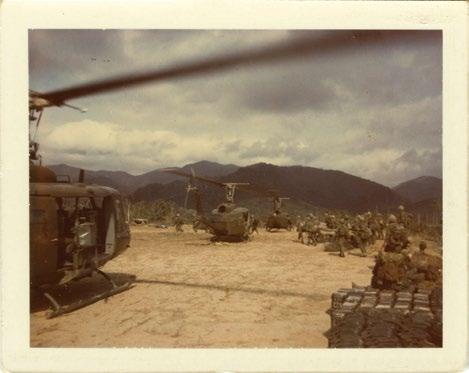
situation on our hands. I’m tremendously proud of my men—the commanding general of Task Force Oregon recommended us all for medals—I’m sure we saved several lives at least. No, more than that because they dragged a few out of the fire before the bunker blew. There were several small explosions afterwards & that evening in spite of the threat of more explosions (the fire was not completely out), my platoon sgt (‘Sgt. Bilko’) & one of my men went back in & pulled out the body of the pilot. I’ve got them all in for the Soldier’s Medal, the non-combat equivalent of the Silver Star (3rd highest decoration).…”
7 August 1967: “Probably next month we will return to the central highlands along the Cambodian border, where last Nov. the battalion lost over 100 men but killed close to 1000 VC. The situation has grown worse and the units operation in that area are in need of reinforcement. Aside from the DMZ, there is no worse area in the country and none of us are looking forward to it. The problem of course is that we’re fighting a war over here with our hands tied, and even then we don’t have enough men for it. Perhaps if we doubled our troop strength here, something definite could be accomplished. In spite of what anyone in the White House says, we are on the defensive and will continue to be until we are sizeably reinforced.”
8 August 1967: “I have to defend a guy at his court martial tomorrow who has refused ‘to kill again.’ It seems he shot a Vietnamese who may not have been a VC & is rather shook up. I think he’s rather weird but the Task Force Oregon psychiatrist says he’s all there. If we didn’t kill some civilians we wouldn’t kill any VC since they all pose as civilians. I think we should kill more— like the Koreans do. But as much as I hate that line of thought, I’ll have to try to prove that he’s justified in his fear to kill civilians—of course I won’t succeed, which is good. Will let you know how it turns out.”
14 August 1967: “These pictures are of some of my men & the new dog, ‘Keats,’ that we have—he’s half
army scout dog as you can see. The bald headed one is Sgt. ‘Bilko’ Kreps. Keats didn’t want to get out in the sun (it’s still very hot) & was very unphotogenic.
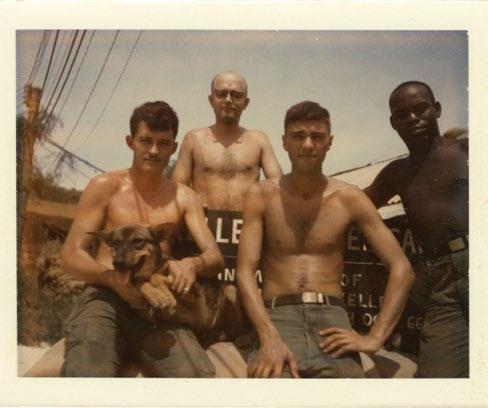
I got that guy I defended off with less than everyone expected. He got 3 months hard labor (breaking rocks down in Saigon) reduction & 2/3 pay per month fine for 3 months. He was expected to get 6 months imprisonment & fine.”
6 September 1967: “Last night, 2 VC btns. attacked the town of Tam Ky, 6 miles up the road from us. Amazingly the South V. garrison there responded & killed about 200 VC (losing only 5 men). The bodies were left in the streets of town all day to reestablish the people’s confidence in the S.V. army. A good move I think, due to the filth & lack of respect for life around here.”
17 September 1967: “The ... 5th marine regiment last week took one of the biggest losses that we’ve had over here: in one day 160 killed, 430 wounded, & they only killed 300 VC. We were all supposed to come down here then. I came down here with the convoy to set up the aid station. The road is supposed to be very insecure, but we encountered nothing, although all the permanent bridges had been blown. My jeep, also the ambulance, was the last vehicle in the convoy which was not too good ...
I’ll be taking my 7 day leave next month....”
18 October 1967: “I won’t be taking another leave after all; it seems that I ‘missed the boat.’ They have just this month adopted a new policy limiting you to only one leave & I’ve had mine. I’m sorry I didn’t go last month or the month before, when I had a chance....“
31 October 1967: “I’ve actually had about enough of ‘Lyndon’s War’ (one yr. of defeatism over here is enough) & this btn. has gone down hill somewhat I’m sorry to say. I don’t really guess I expected anyone to measure up to Col. Miller or Maj. Weinberg though.”
27 November 1967: “We’ve killed almost 100 North Vietnamese (this btn.) in the past several weeks. From the few prisoners we’ve gotten, we have discovered that we have broken up a North V. regiment which has been in the coastal hills here 4 months—mainly because they can’t get supplied. They have been forced to take bold action in search of food & therefore we have been successful with light casualties (7 KIA [killed in action], 20 wounded). But without the bombing of North V. this would never have happened! Still we’re fighting their type of war & will be until Lyndon’s [Johnson] out of the White House.”
7 December 1967: “I won’t be leaving here until Jan. 2.... It seems that the 4th division is not letting any one out early for Christmas probably due to the fact that there are no replacements due to the 1st brigade’s heavy casualties at Dak To....”
30 December 1967: “I’ll be leaving tomorrow, but my port call is not until Jan. 5—I may get out before then however. I’m beginning to wonder if I will be able to make it to Hawaii with the flights so behind schedule....”
10 January 1968: “I most certainly made a wise decision to come over here…. The weather is great; quite a difference from V.N. or the U.S.”
The January 10 “letter” was actually this postcard—which shows Hawaii’s Diamond Head beach. On the back, the card notes “the crystal clear blue-green waters of romantic Waikiki Beach.” Rasmussen was able to visit this exact spot because his VMI roommate Gene Marshall had an office there. Due to a heart murmur, Marshall was assigned a prized administrative job—the handling soldiers on leave to Hawaii from Vietnam (Courtesy of William Rasmussen).

The year-long journey had ended quickly. In 12 hours, a flight out of Vietnam transported Rasmussen from the perils and trials of a war zone to a peaceful paradise
6,000 miles away. In April 1967, massive anti-war demonstrations had begun in the U.S., and in 1968 the protests moved to the gates of the White House and to the fall presidential election. They continued during the presidencies of Richard Nixon until the Paris Peace Accords were signed fifty years ago, in 1973. The disrespect that would be given to Vietnam War veterans did not evolve, however, until some time after Lt. Rasmussen was discharged. Early Vietnam veterans, however, had enough on their minds—the memories that they carried home with them.
Read
–
By Dr. William Rasmussen William Rasmussen, brother of John Curtis Rasmussen, is the former Senior Museum Collections Curator & Lora M. Robins Curator of Art at the Virginia Museum of History & Culture.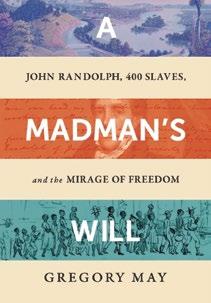


Shop Apollo: When We Went to the Moon merchandise, signed copies of upcoming lecture books, food items and more at the Museum Store on your next visit!
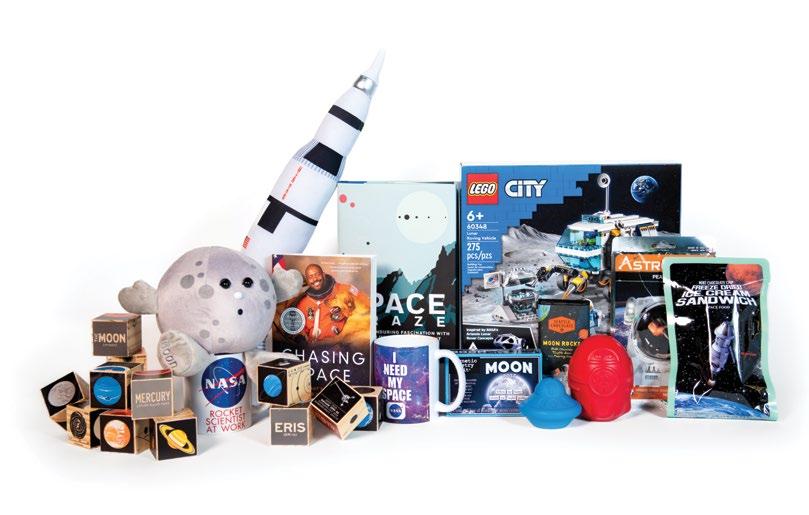

Your purchase at ShopVirginiaHistory.org supports the VMHC’s mission!
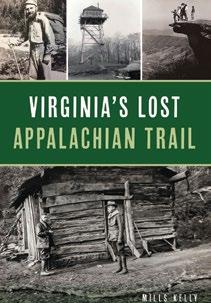
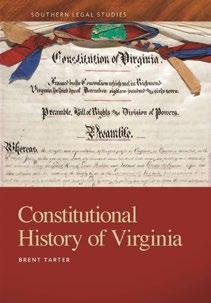
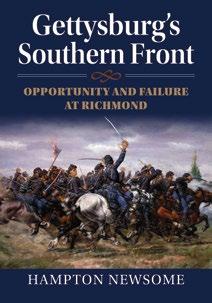
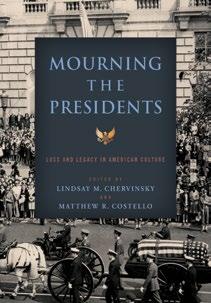
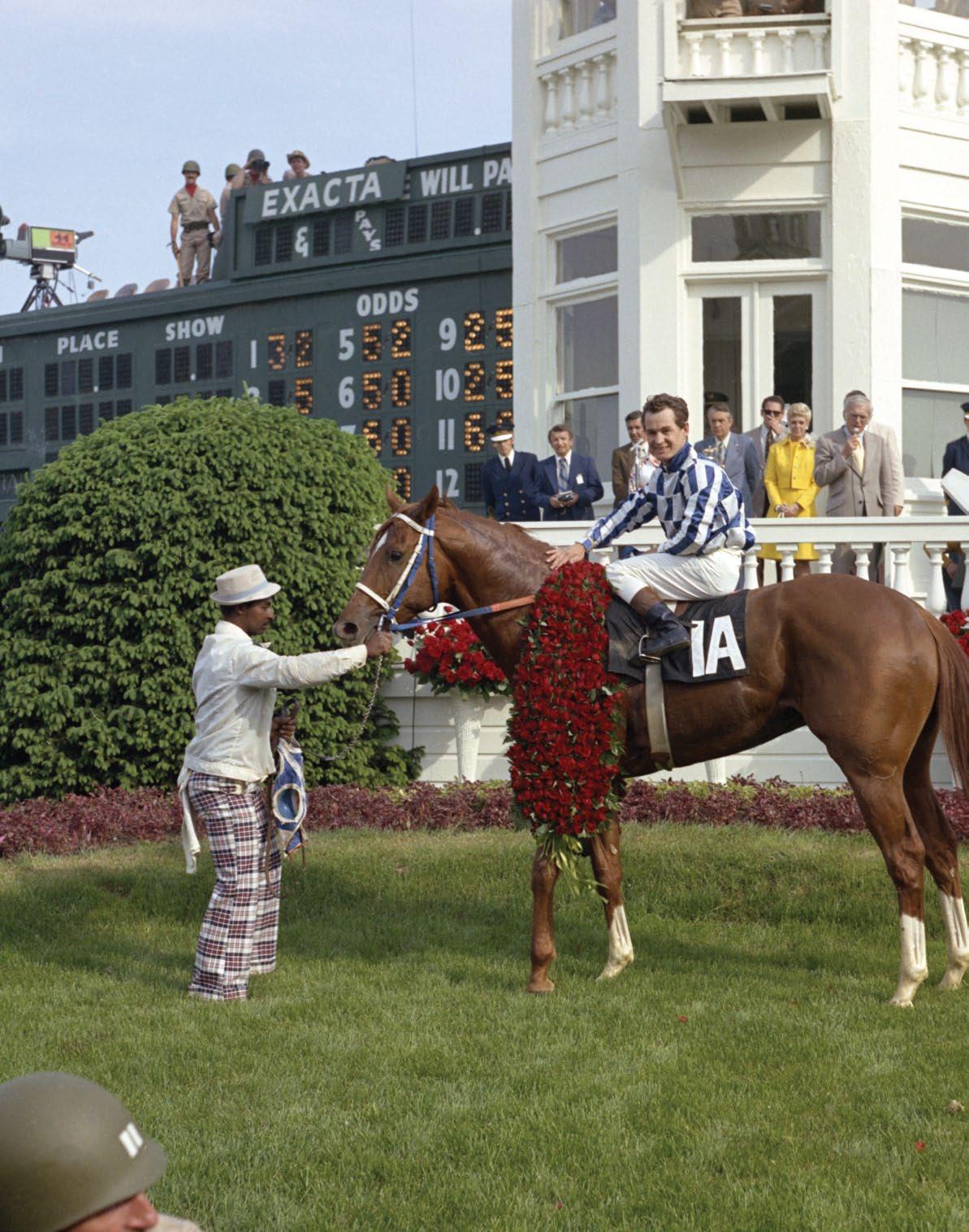 Secretariat in the Kentucky Derby Winner’s Circle, 1973 (Courtesy of Churchill Downs Racetrack).
Secretariat in the Kentucky Derby Winner’s Circle, 1973 (Courtesy of Churchill Downs Racetrack).
Secretariat burst into the American consciousness in the tumultuous time of the 1970s. The country was in the midst of a divisive war in Vietnam, still recovering from the assassination of President John F. Kennedy and enduring the Watergate scandal of President Richard M. Nixon. Sports writers, such as Louisville’s late Billy Reed, credited Secretariat with having an incomparable impact among race horses as the sport’s first TV star, a diversion from Watergate, and a symbol of “nobility in the age of scoundrels.” Secretariat’s athletic achievements still set the standard for Thoroughbred racing, including track records in all three Triple Crown races during his 1973 sweep and winning the Belmont Stakes by an astounding 31 lengths. Secretariat garnered national headlines during his amazing run and still claims a unique position in the history of Thoroughbred racing.

Secretariat had innate athletic gifts and was nurtured by a phenomenal team. The chestnut colt was foaled in 1970 at Virginia’s Meadow Stable. As he grew, many recognized his potential. The St. Petersburg Times (Fla.) described Secretariat as barrel-chested with perfect legs and a prominent white star on his forehead. He was dubbed “Big Red” by his exercise rider, Jim Gaffney. Secretariat’s owner, Penny Chenery, took over operation of the farm from her father, Chris Chenery, in 1967. Although the stable had housed numerous champions, Penny solidified the farm’s legacy while managing the careers of Secretariat and his 1972 Kentucky Derby–winning stablemate, Riva Ridge. Jockey Ron Turcotte and trainer Lucien Laurin, natives of Canada, had great success at home and in the United States before teaming with Meadow Stable. Secretariat’s groom, Eddie Sweat, worked with Lucien for years and joined the trainer in the transition to Meadow Stable.
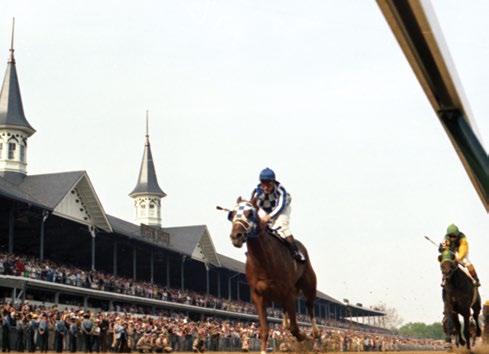
The team found great success with Kentucky Derby and Belmont Stakes winner Riva Ridge in 1972, and the emergence of Secretariat brought continued hope for the future. Winning seven of nine starts as a two-yearold, Secretariat won the Eclipse Award for Horse of the Year in 1972 and became the clear favorite for the 1973 Kentucky Derby. Secretariat prepped for the Run for the Roses at Aqueduct in New York. He won his first two starts that year in the Bay Shore and the Gotham Stakes, but a surprise loss in the Wood Memorial left some doubting his ability to succeed in the Triple Crown. Rumors were rampant claiming Secretariat was not completely healthy while some doubted his ability to get the Derby distance.
Attention turned to the Preakness Stakes, which proved a controversial win. The official time of the race was 1:54 2/5. However, the Daily Racing Form clocked the race at 1:53 2/5, which would have been a Preakness Record. The controversy lasted many years until Secretariat officially obtained the record via a Maryland Racing Commission review in 2012 with an official time of 1:53. Despite the records in the Derby and the Preakness, no one was prepared for what would happen at the Belmont Stakes. Running at a furious pace, Secretariat set a world record of 2:24 for a 1 ½ mile race and won the Belmont by an astounding 31 lengths.
It wouldn’t take long to assure everyone that Secretariat was ready for the challenges of the three-year-old classics. On May 5, 1973, Secretariat came from off the pace to win the Kentucky Derby by 2 ½ lengths. With a time of 1:59 2/5, Secretariat still holds the track record for 1 ¼ miles at Churchill Downs. The pre-Derby criticisms had now turned to accolades. There were comparisons being made to Triple Crown Champions Count Fleet and Citation, and hopes for an end to the 25-year Triple Crown drought were at an all-time high.

Secretariat’s athletic achievements go beyond the track records set in the Triple Crown races. During his three-year-old season in 1973, six of Secretariat’s nine victories either equaled or broke existing records. At the end of that amazing year, Secretariat was named Horse of the Year and champion three-year-old colt. His last two victories of 1973 came on grass surfaces, an achievement that led to his also being named champion male turf horse. He received Thoroughbred racing’s highest honor when he was named to its Hall of Fame in 1974, merely a year after his astounding three-year-old campaign. Upon retirement, Secretariat became a stallion at Claiborne Farm in Paris, Kentucky, and died from complications due to laminitis in 1989. Secretariat’s recognition outside the industry is one of his trademarks. He has been named one of ESPN’s top 100 athletes of the 20th century; has his own U.S. postage stamp; and appeared on the covers of Time, Newsweek, and Sports Illustrated leading up to his record-setting Belmont Stakes win.
An athlete of such importance to the industry lives on in many ways. The late Penny Chenery established permanent platforms in which to protect and promote Secretariat’s legacy. One avenue is Secretariat.com, an online source that celebrates and educates people on Thoroughbred racing’s rich past and its greatest champion. Another is the Secretariat Foundation, a non-profit organization with a mission to assist and
support the Thoroughbred community, especially regarding equine health. In 2010, the Walt Disney Pictures film Secretariat cemented the chestnut Thoroughbred’s legacy among a new generation of fans.
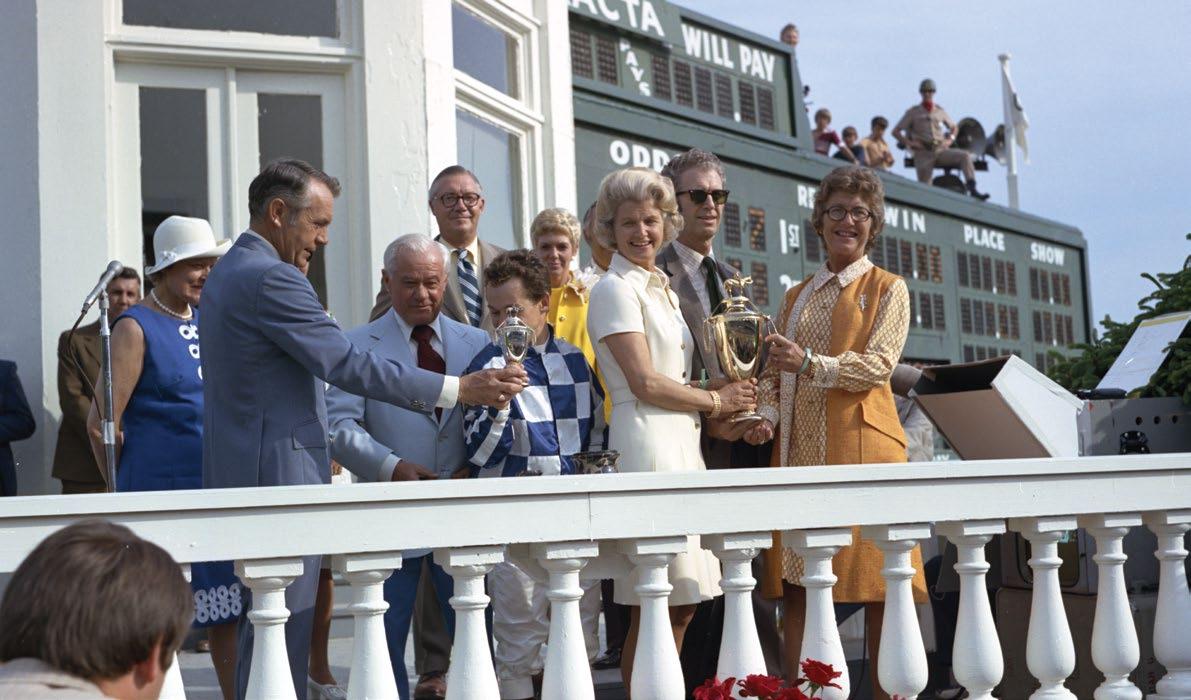
The year 2023 marks the 50th anniversary of Secretariat’s greatest achievements, and celebrations are planned nationwide. Paris, Kentucky, revealed a gigantic mural of Secretariat by artist Jaime Corum in November of 2022. Corum also created a portrait of Secretariat in the Kentucky Derby winner’s circle for the annual collectible bourbon bottle from Kentucky distiller Woodford Reserve. New exhibits and programs will be highlighted throughout the year, including a permanent installation at the Kentucky Derby Museum titled Secretariat: America’s Horse. Virginians can travel to Meadow Event Park in Doswell to learn all about the impact of “Big Red” on the American sports landscape. A larger than life monument is planned for Ashland, Virginia.
Secretariat holds a special place in the history of Thoroughbred racing and is a horse that has transcended the sport. Arriving on the scene at a trying time in America’s history, his athletic achievements served as both a distraction and an inspiration. The 50 years that have passed since his amazing Triple Crown sweep have seen his celebrity grow within and outside of Thoroughbred racing. These 50th anniversary celebrations of America’s Horse will help preserve his memory and the stories of his incredible athleticism for today and future generations.
– By Chris Goodlett Chris Goodlett is the Senior Director of Curatorial & Educational Affairs at the Kentucky Derby Museum. Secretariat’s Connections Accept the Kentucky Derby Trophy, 1973 (Courtesy of Churchill Downs Racetrack).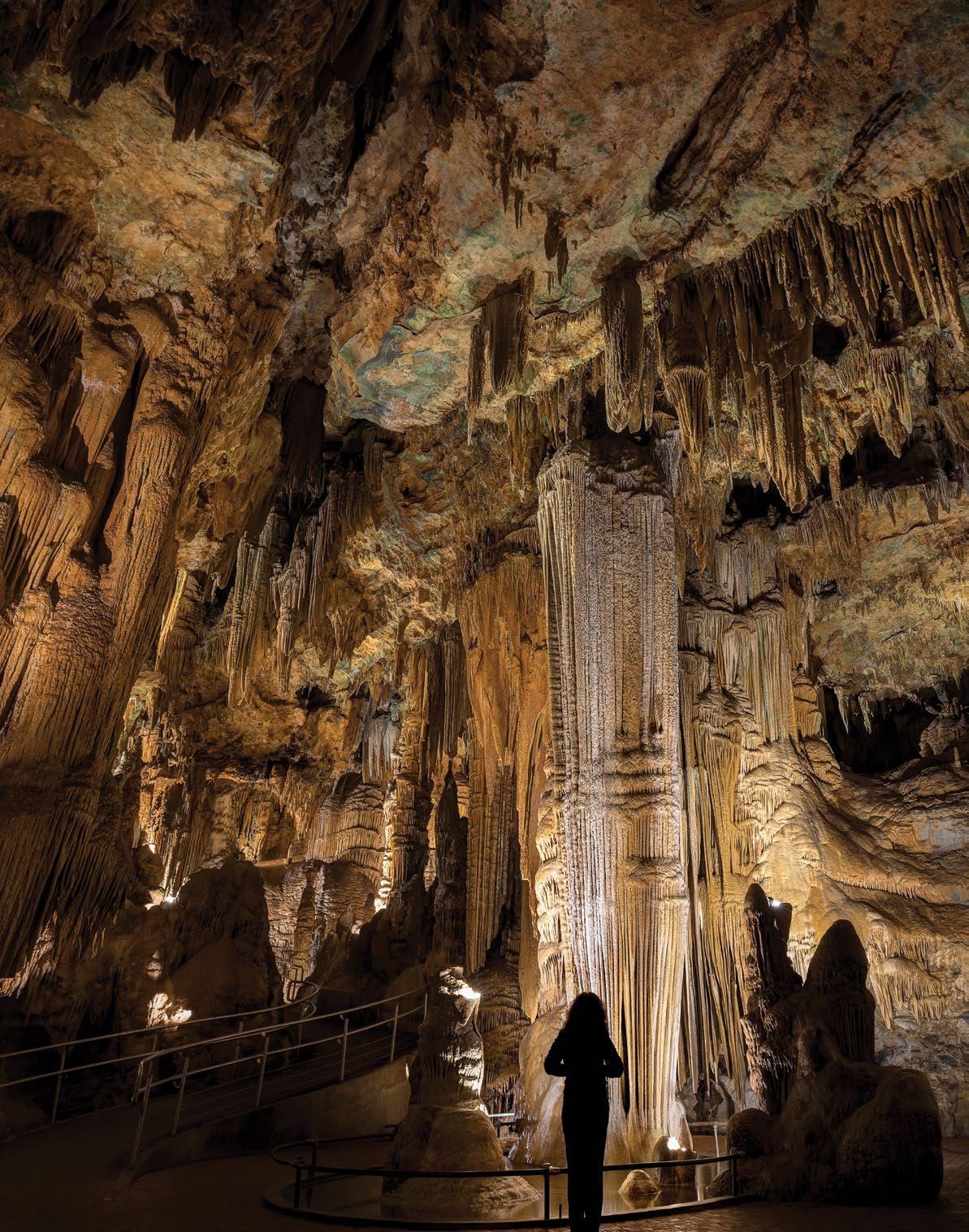 Giant’s Hall, Luray Caverns, Virginia, USA (Courtesy of Getty Images/SergeYatunin).
Giant’s Hall, Luray Caverns, Virginia, USA (Courtesy of Getty Images/SergeYatunin).
Only three Virginia “grottoes”—today we call them caverns—were well known at that date (Gap Cave, at Cumberland Gap, and in Augusta County, Madison’s Cave and Grand Caverns), but reports of others apparently reached Milbert. In the next hundred years, six more significant caverns would in fact be discovered. They were found in Page County (Luray Caverns, 1878), at New Market (Endless Caverns, 1879), Quicksburg (Shenandoah Caverns, 1884), Natural Bridge (Natural Bridge Caverns,1890s), Salem (Dixie Caverns, 1920), and Front Royal (Skyline Caverns, 1937). Of them all, the most extensive and most visually captivating would prove to be the spectacular ones at Luray, the largest and most popular caverns in eastern America.

International reaction to the discovery at Luray was quick. In 1880, the venerable Smithsonian Institution sent a team of nine scientists to examine them and issue a judgement: “Comparing this great natural curiosity with others of the same class, it is safe to say that there is probably no other cave in the world more completely and profusely decorated with stalactite and stalagmite ornamentation than that of Luray.” (Stalactites are mineral formations that hang from the ceiling. Stalagmites are rock formations on the floor built

The Alleghenies, or endless mountains, are divided into small, nearly parallel chains, notable for their natural phenomena, including the numerous grottoes
– Jacques Gėrard Milbert, 1828
up by ceiling drippings.) In 1885 the traveler Ernest Ingersoll marveled, “That rigid stone should lend itself to so many delicate, graceful, airy shapes and attitudes rivaling the flexible flowers of the organic world, fills the mind with astonishment and bewilders the eye.” To an Englishwoman in 1897, they are “unrivaled in the whole known world, and far surpassing in interest of every kind, the great ‘Monmouth Cave’ of Kentucky, gigantic in size, but almost bare.” Those two travelers saw the Luray Caverns illuminated by special lighting (provided by thirteen arc lights powered by an engine-driven generator), installed in 1881. Torches, candles, and rope were no longer needed.
Even those first visitors probably realized that the creation of such profuse natural splendor was a very slow and multifaceted process. Geologists explain that it started eons ago when the chambers at Luray were filled with acidic water that slowly ate away at the softer material of the ceilings, walls, and floors. When the water table lowered, the water in the caverns receded,
dripped into the caverns, sometimes one drip at a time, causing stalactites and stalagmites to form. Some of those formations remained white, but many of the others were colored by chemicals and minerals in the soil and rock layers through which the water passed.
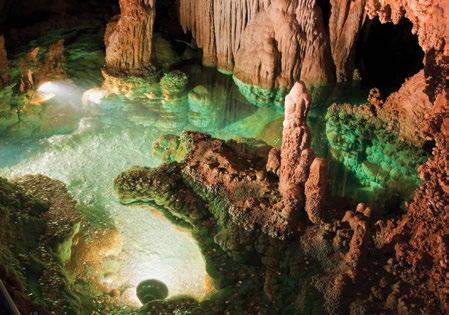
The color at Luray is as conspicuous and impactful as the shapes. The predominate brown coloring came from the clay through which the waters passed, while reds and yellows came from iron and iron-stained clay. Some black, blue, and green coloring came from
Handcolored postcard of Sacred River, the Beautiful Caverns of Luray, Luray, VA, 2nd half 20th c. (VMHC Collection).
 Luray Caverns, Shenandoah National Park, Virginia (Courtesy of Getty Images/Andrew211).
Luray Caverns, Shenandoah National Park, Virginia (Courtesy of Getty Images/Andrew211).
manganese dioxide and copper compounds. Thicker “mud flows” of carbonate minerals left innumerable “flowstone draperies” in the various chambers.
The temperature throughout the Luray Caverns is 54 degrees. A one-and-a-quarter-mile paved curving pathway carries visitors to a depth of eighty feet, and in places to 164 feet. (Parts of the caverns extend even lower, to 260 feet.) Memorable stopping points include “Giant’s Hall,” embellished with columns ten stories tall and stalactites nearly fifty feet in length; the golden “Empress Column” that was formed by the joining of a stalactite and a stalagmite; “Saracen’s Tent”; the “Leaning Column” that tilts like the campanile at Pisa; the mirror-like “Dream Lake” that reflects stalactites; the green “Wishing Well” that over the years has collected a million dollars in coins (all donated to charity); and hundreds of basins, many crystalclear, that are as much as 50 feet in diameter and up to 15 feet deep.
The most fabled of the Luray creations is the world’s largest musical instrument—the “Great Stalacpipe Organ”— an actual working organ that utilizes stalactites as its pipes that are struck by rubber mallets.
Centuries before the Euro-Americans discovered the caverns at Luray, Native Americans knew of them. Human bone fragments, which must be those of Indians, the only humans in the region until the modern era, have been found there embedded in stalagmites. One intact skeleton is believed to be that of a Native American girl. If an estimate based on stalagmite growth around it is correct, it dates back as far as 500 years ago. How it got there is a matter of speculation—did
a burial site collapse into a sinkhole, or did Native Americans select one of the caverns as a tomb?
Euro-Americans discovered the Luray Caverns in 1878 when five local men investigated a sinkhole from which cool air was escaping. Four hours of digging enlarged the hole sufficiently for two of them to descend down a rope. By candlelight they explored sufficiently to determine that the property was well worth purchasing. The landowner sold with no knowledge of the caverns. A lawsuit followed that nullified the sale, then multiple purchases of the property by a series of companies and individuals, and finally in 1905 acquisition by the Luray Caverns Corporation, which remains the owner. Annual visitation in 1906 was 18,000. In 2018 it had risen to approximately 500,000.

For a short period in the early 1900s, before it burned down, a sanatorium was built on the Luray Caverns property for those with respiratory illnesses. Cool air from the caverns was pulled into the building by means of an oversized fan, to maintain a comfortable 70 degree temperature.
Beyond the caverns, additional attractions await the visitor to Luray. The Car and Carriage Caravan Museum houses an extraordinary collection of more than 140 vehicles, including a Conestoga wagon and an 1892 Mercedes-Benz sedan. The Shenandoah Heritage Village is a seven-acre re-creation of a small nineteenthcentury farming community made up of restored historic buildings. The Toy Town Junction Museum presents vintage miniature trains, dolls, and toys. The Luray Valley Museum holds regional artifacts. A one-acre ornamental hedge maze provides a half-mile path.
October 6 – 8
This fall, the Virginia Museum of History & Culture and the Garden Club of Virginia will collaborate in a new and exciting way to present History Blooms - a unique, multi-day program that seamlessly integrates the missions of both historic and beloved institutions.
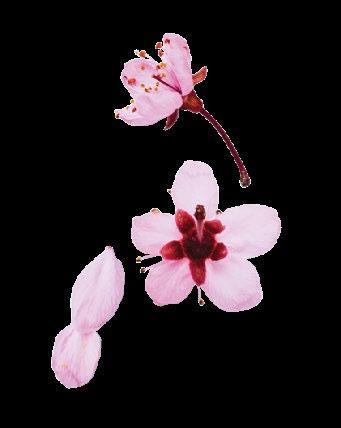
History Blooms is an immersive experience that will showcase Virginia’s rich history through stunning and creative floral displays presented thematically throughout your state history museum. Each arrangement, inspired and produced by the Garden Club’s statewide network, will help tell the story of Virginia’s distinctive people and places. Throughout the weekend, a series of enriching lectures, workshops and other events will be presented—bringing together important voices in history and horticulture.
Registration opens August
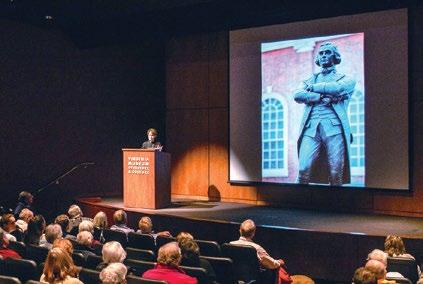
November 4
Historians, practitioners, and members of the public will gather at the VMHC to explore our shared past. Featuring panels and presentations that highlight groundbreaking research into Virginia history, tailored gallery tours that celebrate Virginia discoveries, and a special keynote lecture and reception, this new symposium will link past with present and inspire future generations.
Registration opens mid-August
In March of 1773, leading Virginia burgesses met in a private room at the Raleigh Tavern in Williamsburg. Richard Henry Lee, Thomas Jefferson, Patrick Henry, and others crowded around to pen a resolution for the establishment of a “standing committee of correspondence and inquiry.” These Virginians had a vision to bring unity to the thirteen colonies of North America. Their efforts contributed to the establishment of a communications network that facilitated what Pulitzer Prize–winning historian Joseph Ellis has called the first national dialogue in American history.
In March of 2023, exactly 250 years later, a national dialogue was reestablished. On this special anniversary, the VMHC joined forces with Colonial Williamsburg and Virginia’s American Revolution 250 Commission (of which the VMHC plays a leading role) to host the first national event of America’s semiquincentennial. Representatives from 35 states, including leaders of state

history organizations and 250th planning commissions, gathered at Colonial Williamsburg for a three-day planning summit. The assembly of more than 300 people enjoyed a series of presentations, including research studies on how Americans want to commemorate such an occasion and how to navigate real and perceived political division. The group also enjoyed a number of inspirational activities in the historic area and moving speeches by prominent national speakers, including former Associate Justice of the United States Supreme Court Anthony Kennedy, Chair of the Colonial Williamsburg Foundation Carly Fiorina, award-winning journalist Bill Whitaker, and Pulitzer Prize–winning author Stacy Schiff.


